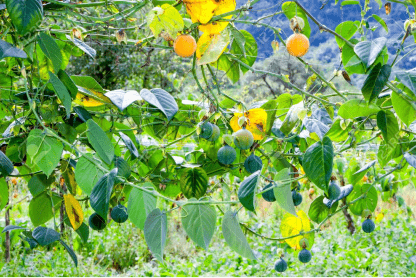-
Colombian Coffee
Colombian Coffee
-
Brazilian Coffee
Brazilian Coffee
-
Pineapple
Pineapple
-
Banana
Banana
-
Olive Oil
Olive Oil
-
Passion Fruit
Passion Fruit
-
Gulupa
Gulupa
-
Granadilla
Granadilla
-
Pitahaya
Pitahaya
-
Gooseberry
Gooseberry
-
Grape
Grape
-
Soursop
Soursop
-
Lulo
Lulo
-
Mango
Mango
-
Tamarillo
Tamarillo
Our Brochures
Contact Us
Social Media


- Granadilla is a tropical fruit belonging to the passionflower family, just like gulupa and passion fruit.
- It has a round or oval shape, similar to a small egg, and its skin is hard and rough.
- The pulp of granadilla is gelatinous and filled with small edible seeds.
Health Benefits
- Rich in Antioxidants: Granadilla is rich in antioxidants, such as vitamin C, which help combat oxidative stress and protect cells from damage caused by free radicals.
- Vitamin C: Contributes to the health of the immune system and may assist in iron absorption.
- Dietary Fiber: The fiber in granadilla pulp can promote healthy digestion, prevent constipation, and maintain a healthy digestive system.
- Potassium: Granadilla helps maintain electrolyte balance and cardiovascular function.
common usses
- Granadilla is consumed fresh and used in juices, smoothies, desserts, ice creams, and cocktails.
- It is also used to make jams, jellies, and confectionery products.
- Its pulp can be used to flavor and aroma beverages and baked goods.
- Granadilla is appreciated for its sweet-tart flavor and is a versatile fruit in the kitchen, used in a variety of culinary preparations and refreshing beverages. In addition to its pleasant taste, it offers nutritional and antioxidant benefits.
Some of the places
where this fruit is grown
- South America: Granadilla is native to South America and is cultivated in various countries in the region, including Colombia, Ecuador, Peru, and Bolivia. These countries have suitable climates for its cultivation.
- Central America: In Central America, granadilla is grown in countries such as Costa Rica, Guatemala, and Honduras. These nations also have favorable climatic conditions for its production.
- Africa: Granadilla is cultivated in African countries with tropical climates, such as South Africa and Kenya. In South Africa, in particular, it is a popular and widely grown fruit.
- Africa: Granadilla is cultivated in African countries with tropical climates, such as South Africa and Kenya. In South Africa, in particular, it is a popular and widely grown fruit.
- Australia: In Australia, granadilla is grown in subtropical and tropical regions, such as Queensland. It is locally known as “passionfruit” and is appreciated for its flavor.
- Asia: In some parts of Asia, such as India and Sri Lanka, granadilla is also cultivated in regions with suitable climates. However, its cultivation is not as common as in other parts of the world.
Nutritional Properties (per 100 grams)
granadilla
- Calories: Approximately 97 kcal
- Carbohydrates: About 23.4 grams
- Fiber: Approximately 1.5 grams
- Proteins: Around 1.5 grams
- Fats: Approximately 0.5 grams
- Vitamin C: Contains a significant amount of vitamin C, which is an important antioxidant.
- Vitamin A: Contributes to the recommended daily intake of vitamin A.
- Minerals: Granadilla is a good source of potassium and iron.
